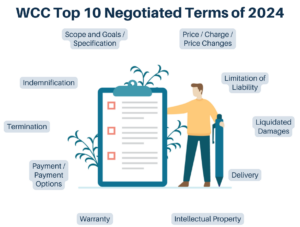Imagine you’re browsing Netflix, trying to find that perfect movie/show that you can watch while eating. You know exactly what you need, but finding the right movie/series can be frustrating. Similarly, finding the right vendor for procuring CLM Software can be overwhelming. Fear not! In this article, we’ll provide you with a step-by-step guide on how to create a compelling CLM software RFP (Request for Proposal). This will streamline the vendor selection process while ensuring that you find the ideal solution for your legal operations.
Crafting a well-structured and comprehensive CLM software RFP is the key to success in finding the perfect vendor and optimizing your contract management processes.
A properly designed CLM software RFP serves as a roadmap for evaluating vendors and clarifies your requirements. It helps you communicate your needs effectively, ensuring that potential vendors understand your expectations. Additionally, an effective RFP saves time and resources by streamlining the vendor selection process, ultimately leading to better contract management outcomes.
A step-by-step process for CLM Software RFP

- Define your objectives: Clearly outline your goals, pain points, and desired outcomes from implementing a CLM software solution. This step sets the foundation for the entire RFP creation process.
- Research and shortlist vendors: Conduct thorough research to identify potential CLM software vendors that align with your requirements. Shortlist the most promising candidates based on factors like reputation, experience, and solution features. You can read our blog about How to choose the right CLM Software for more detailed information.
- Create an RFP outline: Develop a well-structured outline that covers the essential sections of an RFP, such as an introduction, background information, scope of work, technical requirements, implementation timeline, pricing, and evaluation criteria.
- Provide detailed requirements: Clearly articulate your specific needs and functionalities required in the CLM software. Specify features like contract creation, automated workflows, document management, compliance tracking, and integration capabilities.
- Include performance and security standards: Emphasize the importance of performance and security in your RFP. Set expectations for system uptime, response times, data encryption, user access controls, and compliance with relevant regulations like GDPR or CCPA.
- Request vendor qualifications: Ask vendors to provide details about their company background, experience, client references, and certifications. This helps you evaluate their expertise and credibility.
- Evaluation criteria: Define the evaluation criteria that will be used to assess vendor proposals. Consider factors like solution functionality, scalability, ease of use, implementation process, customer support, and total cost of ownership.
- Deadlines and submission instructions: Clearly communicate the submission deadline and provide instructions on how vendors should format and submit their proposals. Include any specific requirements for pricing details or case studies.
Why follow this step-by-step process?
This Step-by-step Process ensures that your CLM software RFP is comprehensive, clear, and focused. It minimizes ambiguity, helps vendors understand your requirements better, and allows for an apples-to-apples comparison of proposals. By following this comprehensive guide to creating a CLM software RFP, legal professionals can effectively:
- Communicate their needs
- Save time during the vendor selection process
- Ultimately choose the best CLM software solution for their organization.
This translates into enhanced contract management, improved compliance, and increased efficiency in legal operations. Volody’s AI CLM Software simplifies contract management, streamlines workflows, and enhances collaboration.
Best practices for creating a CLM Software RFP
- Collaborative approach: Involve key stakeholders from legal, procurement, and IT departments in the RFP creation process. Their input will ensure that all requirements and concerns are addressed, leading to a more comprehensive and effective RFP.
- Clear and concise language: Use clear and concise language throughout the RFP document. Avoid jargon and technical terms that may be unfamiliar to vendors. This ensures that vendors can easily understand and respond to your requirements.
- Specificity in requirements: Be specific and detailed when outlining your requirements. Instead of vague statements like “user-friendly interface,” provide specific examples or desired functionalities that you expect from the CLM software. This clarity helps vendors tailor their proposals to meet your specific needs.
- Realistic timeframes: Set realistic timeframes for the submission of proposals, vendor selection, and implementation. Rushing the process can lead to inadequate vendor evaluation and compromise the success of the CLM implementation. Allow sufficient time for vendors to prepare comprehensive proposals and for your team to evaluate them thoroughly.
- Evaluation criteria alignment: Ensure that the evaluation criteria align with your organization’s objectives and priorities. Consider the importance of each criterion and assign appropriate weights to reflect their significance. This approach enables an objective evaluation and comparison of vendor proposals.
- Request for demonstrations or proof of concept: If feasible, include a request for vendor demonstrations or proof of concept as part of the evaluation process. This allows you to assess the usability and functionality of the CLM software firsthand, ensuring it meets your requirements before finalizing a vendor.

Benefits of implementing a CLM Software Solution
- Enhanced contract visibility: CLM software provides a centralized repository for contracts, ensuring easy access and visibility across the organization. This eliminates the risk of misplaced or lost contracts, enabling efficient tracking and management.
- Streamlined workflows: CLM software automates and streamlines contract processes, from creation and negotiation to approval and renewal. Workflow automation reduces manual errors, minimizes delays, and increases efficiency in contract management.
- Improved compliance and risk management: With CLM software, organizations can establish standardized contract templates, enforce approval workflows, and track compliance obligations. The software can also generate alerts for key contract milestones, ensuring timely actions and mitigating risks.
- Cost and time savings: By automating manual tasks and streamlining processes, CLM software saves valuable time and reduces administrative costs associated with contract management. It enables legal professionals to focus on strategic initiatives and high-value activities.
- Data-driven insights: CLM software captures and analyzes contract data, providing valuable insights into contract performance, obligations, and risks. These insights enable informed decision-making, identification of improvement opportunities, and negotiation of favorable terms with suppliers or clients.
- Enhanced collaboration and communication: CLM software facilitates collaboration among stakeholders involved in the contract lifecycle. It enables real-time access to contracts, streamlined communication, and document sharing, fostering effective collaboration within the legal team and with external parties.
Implementing a CLM software solution brings significant benefits to organizations, including increased efficiency, improved compliance, cost savings, and better contract management. By following best practices in creating a comprehensive CLM software RFP, legal professionals can ensure a successful vendor selection process and leverage the advantages of CLM technology for their organization’s success.
PS: Look at which Top Legal AI Assistants your peers are using to streamline their workflow in 2023.
To conclude,
Crafting a comprehensive CLM software RFP is a vital step toward finding the ideal vendor and optimizing your contract management processes. By following the step-by-step process outlined in this guide, legal professionals can effectively communicate their requirements, streamline vendor selection, and achieve better contract management outcomes. Volody’s AI CLM software provides the ultimate solution with its advanced AI & ML features, ensuring efficient contract management and addressing the pain points faced in internal linking. To be updated with what’s currently trending in the legal-tech sector, have a look at our weekly blogs and to know how Volody’s AI CLM software can transform your contract management processes, drop down a comment and we will show you how the magic works.





